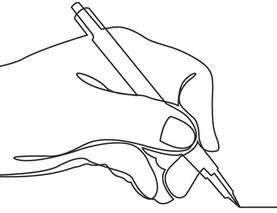|
Instructor: Madeline Owen
|
"DRAWING FOUNDATIONS" In this 4-module, 36-lesson course with Madeline Owen we will focus on drawing fundamentals to equip students with the skills to create dynamic and engaging drawings. All skill levels are welcome, from students who draw everyday to those who have not drawn anything more than a stick figure. |
Course Description
Students will keep a sketchbook for the duration of this class, which they will be using for class exercises and homework assignments. A typical lesson will start with a demonstration of the concepts to be covered, followed by a group draw-along where Madeline will show the technique step by step. After the step by step tutorial, students will be given assignments to start in class and complete at home. By the end of this course, students will not only gain confidence in their drawing abilities, but will also be able to create interesting works of art. The skills learned can be applied to drawing for animation and digital art as well.
Students will keep a sketchbook for the duration of this class, which they will be using for class exercises and homework assignments. A typical lesson will start with a demonstration of the concepts to be covered, followed by a group draw-along where Madeline will show the technique step by step. After the step by step tutorial, students will be given assignments to start in class and complete at home. By the end of this course, students will not only gain confidence in their drawing abilities, but will also be able to create interesting works of art. The skills learned can be applied to drawing for animation and digital art as well.
Module 1- Material Handling and Observational Drawing Fundamentals
Learning Objectives-
In the first 9 lessons of this class Madeline will introduce the foundational key concepts of drawing. These concepts are the foundation for which the following more advanced classes are built on. In this class, we will be drawing simple shapes and objects and will focus on line quality, material handling, light shading, and basic observational techniques.
These first 9 classes are an intro to-
-basic drawing materials (L1)
-holding and manipulating a pencil to create interesting line quality and why line quality is important in drawings (L1-3)
-light shading and how it affects the form of a drawing (L4-6)
-basic observational techniques and problem solving skills in regards to fixing proportion (L3-9)
Module 2- Starting a Drawing with the Block-In Method (Lesson 10 -18)
Learning Objectives-
In the second section of this course, we will build on the foundational drawing concepts we learned in the first 9 lessons to create more realistic and complex drawings. We will also be introduced to the concept of the “block-in” which is an age-old approach to beginning drawings that consists of simplifying forms into straight lines and simple shapes. We will begin with copying Bargue templates to study the structure of block-ins, shadow shapes, and proportion. After Bargue we move on to work from photo references of simple still lives. This second block is solely meant to sharpen observational skills and prepare students for more complicated subject matter in later classes.
The second 9 classes will cover-
-identifying core shadows, reflected light, and highlights (lesson 10-11)
-the block-in using Bargue templates (lessons 10-15)
-using a photo reference when drawing a block in (15-18)
Rubric for Module 1 and 2
-draw lightly and darken and strengthen the lines as needed
-shade evenly with smooth gradations
-use drop lines and cross comparison lines in order to draw accurate proportion
-use the block in method to simplify complicated forms into straight lines
-identify and draw shadow shapes using cross comparison lines and drop lines to check for accurate proportion
Module 3- The Fundamentals of Portraiture (Lesson 19-26)
Learning Objectives-
In the third section of the course we will use the skills learned in the previous two sections to draw believable and engaging portraits. Students will learn how to observe a subject and achieve a certain level of likeness in their drawing. Students will also learn the basic structures of facial anatomy in order to be able to draw portraits from imagination.
The third 9 lesson will cover-
-simple facial anatomy and structure (L19-23)
-how to use shadow shapes when drawing a portrait (L19-23)
-how to achieve likeness when drawing a portrait (L 23-25)
-portrait drawing from imagination (L 26)
Module 4- Experimentation with Materials, Atmosphere, and Mark Making
(Lesson 27-36)
Learning Objectives-
In the last section of this class, students will experiment with different drawing media and learn techniques to create engaging and dynamic works of art. This includes giving atmosphere and an interesting composition which will highlight a main focal point of the drawing. Students will be encouraged to consider what they are trying to communicate with their drawings and how to best manipulate the materials and compositions of their works to support the aim of each drawing.
The last 9 lessons will cover-
-composition fundamentals (L 27)
-how to use contrasting values to guide the viewer's eye to a focal point (L27-29)
-how to use different drawing media and shading techniques (L29-35)
-expressive mark-making and disrupting the form (L33-37)
Rubric for Entire Course-
By the end of the course, students will be graded on ability to-
-draw lightly and darken and strengthen the lines as needed
-shade evenly with smooth gradations
-use drop lines and cross comparison lines in order to draw accurate proportion
-use the block in method to simplify complicated forms into straight lines
-identify and draw shadow shapes
-draw with a wide range of values
-guide the viewer's eye to a central focal point
-draw a portrait using good line quality and even shading, with proportions as accurate as the student can draw them with their current skill level
-have openness and curiosity when experimenting with new materials and different ways to shade a drawing
Cost: $499 (per 9-class Module)


